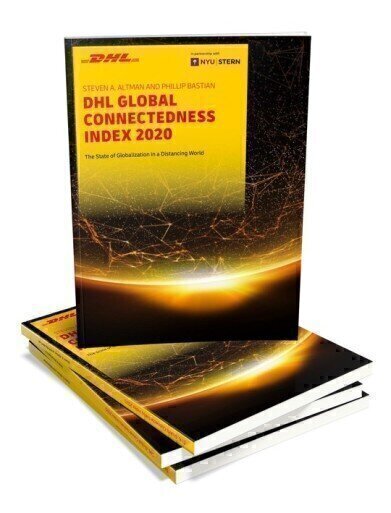News & Views
DHL Global Connectedness Index 2020 Signals Recovery of Globalisation from COVID-19 Setback
Dec 03 2020
DHL and the NYU Stern School of Business released the DHL Global Connectedness Index 2020 (GCI). The report, now in its seventh edition, is the first comprehensive assessment of globalisation during the spreading COVID-19 pandemic. It tracks international flows of trade, capital, information and people across 169 countries and territories. After holding steady in 2019, current forecasts imply that the index will fall significantly in 2020 due to the distancing effects of COVID-19 on societies, such as closed borders, travel bans and grounded passenger airlines. Nonetheless the pandemic is unlikely to send the world’s overall level of connectedness below where it stood during the 2008 - 09 global financial crisis. Trade and capital flows have already started to recover and international data flows surged during the spreading pandemic as in-person contact went into the online world. The main drivers of this ‘digital globalisation’: online data traffic, telephone calls and e-commerce, which recorded a strong increase.
While COVID-19 has disrupted business and life around the world, it has not severed the fundamental links that connect nations. “This report shows that globalisation did not collapse in 2020, but that the pandemic did transform, at least temporarily, how countries connect. It also demonstrates both the dangers of a world where critical linkages break down and the urgent need for more effective cooperation in the face of global challenges,” commented GCI lead author Steven A. Altman, Senior Research Scholar and Director of the DHL Initiative on Globalisation at the NYU Stern School of Business. “Stronger global connectedness could accelerate the world’s recovery from the COVID-19 pandemic, as countries that connect more to international flows tend to enjoy faster economic growth.”
Predictably, lockdowns and travel bans to curb the spread of the virus have led to an unprecedented collapse of people flows in 2020. The number of people traveling to foreign countries is on track to fall 70% in 2020, according to the latest UN forecast. International tourism may not return to its pre-pandemic level until 2023. In contrast, trade, capital, and information flows have held up surprisingly well. International trade has rebounded strongly after a sharp plunge at the onset of the pandemic and remains a vital backbone for economies worldwide.
Capital flows were hit harder. Foreign direct investment (FDI) flows, which reflect companies buying, building or reinvesting in operations abroad, could fall 30-40% this year, as also projected by the UN. However, strong policy responses by governments and central banks have helped to stabilise markets. Digital information flows have surged as the pandemic has sent work, play and education online. People and companies rushed to stay connected digitally, driving double-digit increases in global internet traffic.
The DHL Global Connectedness Index employs more than 3.5 million data points to track the globalisation of 169 countries over the period from 2001 to 2019. It measures each country’s global connectedness based both on the size of its international flows relative to the size of its domestic economy (‘depth’) and the extent to which its international flows are distributed globally or more narrowly focused (‘breadth’).
The most recent data show that The Netherlands is again at the top of the ranking as the world’s most globally connected country. Singapore, Belgium, the United Arab Emirates and Ireland complete the top 5. Singapore leads the index on international flows relative to domestic activity. Further, no country boasts a more global distribution of flows than the United Kingdom. Europe claims the top spot as the world’s most globalised region, with 8 of the 10 most globally connected countries located there. It leads on trade and people flows, while North America is the top region for information and capital flows. The list of economies that are seen to punch well above their weight in terms of international flows is led by Cambodia, Singapore, Vietnam and Malaysia, with regional supply chains a key factor in the performance of Southeast Asian nations.
More information online
Digital Edition
Lab Asia 31.2 April 2024
April 2024
In This Edition Chromatography Articles - Approaches to troubleshooting an SPE method for the analysis of oligonucleotides (pt i) - High-precision liquid flow processes demand full fluidic c...
View all digital editions
Events
Apr 25 2024 Istanbul, Turkey
Apr 28 2024 Montreal, Quebec, Canada
May 05 2024 Seville, Spain
InformEx Zone at CPhl North America
May 07 2024 Pennsylvania, PA, USA
May 14 2024 Oklahoma City, OK, USA


















